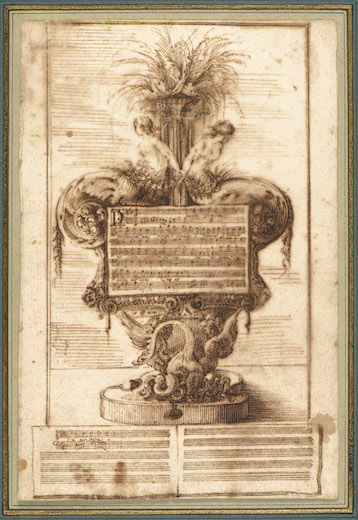A Design for an Elaborately Decorated Vase
Stefano della Bella
* 1610 in Florence † 1664 in Florence
Pen and brown ink and brown wash. Size of sheet: 19.5 x 13 cm.
An Elaborate Vase Decorated with Nymphs, Snakes, a Swan and a Musical Score. Extensively inscribed on the musical scores at the centre and at the lower left. Watermark: Paschal lamb in a double circle [partial] (similar to Briquet 58-61; Rome 1531-1535, Naples 1548, 1570 and 1584).
Sold
The nymphs in the present sheet are particularly close to those flanking one of the vases in one of the Raccolta di vasi iversi etchings (3), as well as a preparatory drawing for the etching in the Louvre (4). As Phyllis Dearborn Massar has noted of the Raccolta di vasi diversi etchings, ‘Fantastic vases, often based on antique bronzes, were perenially favorite subjects with printmakers. Stefano outfantasied all of them, both in the vases themselves and their exuberant contents.’ (5) The words of the sheet music which forms the central motif of this drawing seems to be a sonnet of sorts. Although the text is fragmentary, it can be read as ‘Dammi fortuna / parlami al Core piaga d’Amore li ridarò / cieca importuna tu dici nò nò cieca impor- / tuna tu dici cosi(?) nò nò’, while the text continues at the bottom of the sheet with the words ‘si pur felice’ (6).
Notes
1. Alexandre de Vesme and Phyllis Dearborn Massar, Stefano della Bella: Catalogue Raisonné, New York, 1971, Vol.I, pp.156-158, nos.1027-1044; Vol.II, pp.224-228, figs.1027-1044. See, in particular, nos.1033 and 1036.
2. Ibid., Vol.I, pp.158-159, nos.1045-1050; Vol.II, pp.229-230, figs.1045-1050.
3. de Vesme and Massar, op.cit., Vol.I, p.159, nos.1049; Vol.II, p.230, fig.1049.
4. Inv. 405-1; Françoise Viatte, Musée du Louvre: Cabinet des dessins. Inventaire général des dessins italiens II: Dessins de Stefano della Bella, Paris, 1974, pp.104-105, no.145, fig.145, a detail illustrated on p.15.
5. Phyllis Dearborn Massar, Presenting Stefano della Bella: Seventeenth-century Printmaker, New York, 1971, p.71.
6. A very rough translation of this text would be: ‘My fortune, speak to my heart, sore with love, I will give them back, blind persistence you say no, no, blind persistence you only say no, no...be happy in any case.’ In a note to a previous owner, Robert Spencer suggested that the music of the aria illustrated in this drawing is ‘for voice and harpsichord (unfigured bass) in the style of Alessandro Stradella (1644-82) or Alessandro Scarlatti (1660-1725)’, although at the time the drawing was thought to be the work of a later artist; the Bolognese theatre designer, engraver and musician Carlo Antonio Buffagnotti (b.1660).
